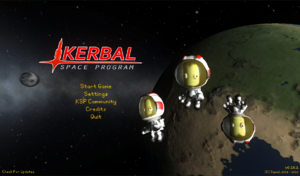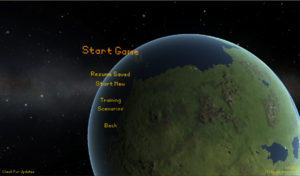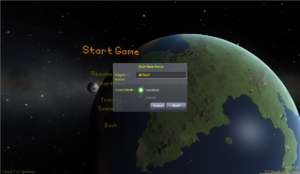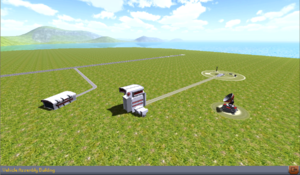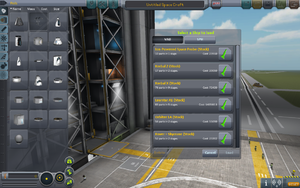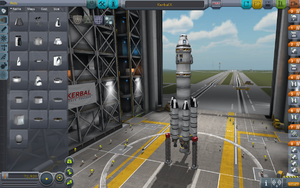Getting Started
This guide is intended to help you through your first few hours with Kerbal Space Program. Although it's far from comprehensive, you should have a decent understanding of the basics.
Contents
Buying
Squad provides a fairly straightforward storefront from which you can buy KSP.
- Visit http://kerbalspaceprogram.com
- Click on the store
Downloading
Squad, the makers of Kerbal Space Program, have a simple download tool used to download, update, and repair the game. It can also choose to download the game from the powerful Amazon S3 cloud when the main servers are under load.
- Go to the store.
- Log in with your username and password.
- Click on the Profile button.
- Scroll down to the bottom and select the download link next to the purchase invoice.
- Download the patcher for your platform into an empty folder.
- Mac users:
- Ensure the execute permission is set on the Patcher.command file.
- Install Mono from the bundled .dmg file, if needed.
- Run Patcher.command.
- Windows Users:
- Install .NET Framework 4.0 or above, if needed. (New versions of Windows already have it.)
- Run Patcher.exe.
- Mac users:
Running the Game
Once the game is installed, it is time to run it. This is done by browsing to the folder the game was unpacked in and running KSP.exe. A shortcut can be made on the Desktop to this file which will make running the game a bit faster, unless you want to run it from a USB drive and have all of your game information with you for playing on any computer.
The main screen has the following links:
- Start Game
- Settings
- KSP Community
- Credits
- Quit
By selecting the Start Game menu item, the Start and Load Game menu will appear.
When starting a new game, which is what this portion of the WIKI is assuming, the save game name does not have to remain 'default'. Change this to what ever name you want the save file to be.
Once the new game is started, the Launch Compound with the two assembly bays, tracking station, and launch pad will appear.
The Rocket!
Since a rocket is needed, select the middle structure, it will say Vehicle Assembly Building. From here we will begin the first rocket using a stock rocket.
By selecting the Orange Folder in the top right section of the window, the menu shown in Figure 5 will appear. Find and select the Kerbal X (stock). This will load up the rocket, Kerbal X. This rocket is fairly simple and can easily achieve orbit around the planet. If you are using the demo version, Here is a simple rocket I made that has achieved orbit with more than enough fuel for the return to the planet.
While this rocket appears to be a bit complex, it is really simple and can easily be explained. On the right side of the screen, shown in Figure 6, there are orange folders that have numbers ranging from 1 to 8. These are the launch stages that your rocket has. Launch stages are different than your rocket stages as the stages that make up the launch stages are what the spacebar triggers with each press. Each stage has at least one icon inside of it. These are the events of that stage. The launch stages are thus:
- Rocket Launch Stage 8
- This is your initial launch stage
- There are a total of seven Liquid Fuel Thrusters that are activated on this stage
- Rocket Launch Stage 7
- This is the second launch stage
- This launch stage releases the support braces, TT18-A Launch Stability Enhancers, that are shown at the bottom of the Kerbal X Rocket
- The TT18-A LSEs are the open frame supports capped with the red cap
- Rocket Launch Stage 6
- This, the third, launch stage releases two of the boosters from the main rocket
- This stage should only be triggered after the first set of two boosters are out of fuel
- There is an audible cue as well as a visual indicator when a rocket engine is out of fuel
- Rocket Launch Stage 5
- After a short while two more engines will run out, and pressing the spacebar will activate this stage to release them off of the main rocket
- Again, only trigger this stage *after* two more engines have run out of fuel
- Rocket Launch Stage 4
- This is the same as the previous two launch stages
- The main difference here is that this is the last set of the booster engines for this rocket
- Rocket Launch Stage 3
- This is the end of the first stage of the rocket
- When the spacebar is pressed, the main engine that helped the boosters get the rocket into space will separate from the second stage of the rocket
- Rocket Launch Stage 2
- This stage starts up the smaller engine attached directly to the capsule
- Rocket Launch Stage 1
- This is the last stage before the parachute is opened
- Since this is the last stage that will release the last engine, it is suggested *not* to activate it until you are on the return trip towards the planet
- Rocket Launch Stage 0
- This is the absolute last stage that deploys the parachute when activated
That is the run down of the orange tabs on the right side of the screen. While there is nothing that really *needs* to be done to the Kerbal X Rocket, I strongly advise adding a couple of items that will make getting into orbit a bit easier.
Launching the rocket
Once you've made or selected a rocket, press the big green launch button in the top right.
Flight controls are not exactly straightforward. W, S, A, and D move the ship around, but they are relative to your rotation, controlled with Q and E. The easiest way to keep your rocket on target with WSAD is to look at the navball, in the bottom middle of the screen.
Before launching your rocket, take a second to look at your map, by pressing M. This will bring up Kerbin on the map. Scroll out to show kerbins moons, and even farther to see the rest of the solar system. It will be a while before you even learn how to make a rocket than can escape the sphere of influence of Kerbin, so experiment with different rocket designs, and see what works best for you.
Launching your rocket is the easy part. Just press space. But don't do that just yet, press T to turn SAS on. SAS is essentially autopilot, without SAS you just won't turn as well. Pure SAS allows you to control the movement of your rocket with the WSADQE keys faster, and with more power, however it is nothing compared to ASAS (Advanced SAS). Advanced SAS allows your rocket to use thrust vectoring (You'll learn about that later too) and it keeps you on course, instead of you having to turn manually.
Each time you run out of fuel in a stage, press space until the next stage of fuel and engines start burning.
If you don't want to read everything I said above all you need to know is before launching press T, than press space to launch and if your rocket stops going, press space again.
Still To Do
- Getting into an orbit with enough fuel for re-entry
- Getting back down safely
- Links for additional tips, tricks, and guidance
